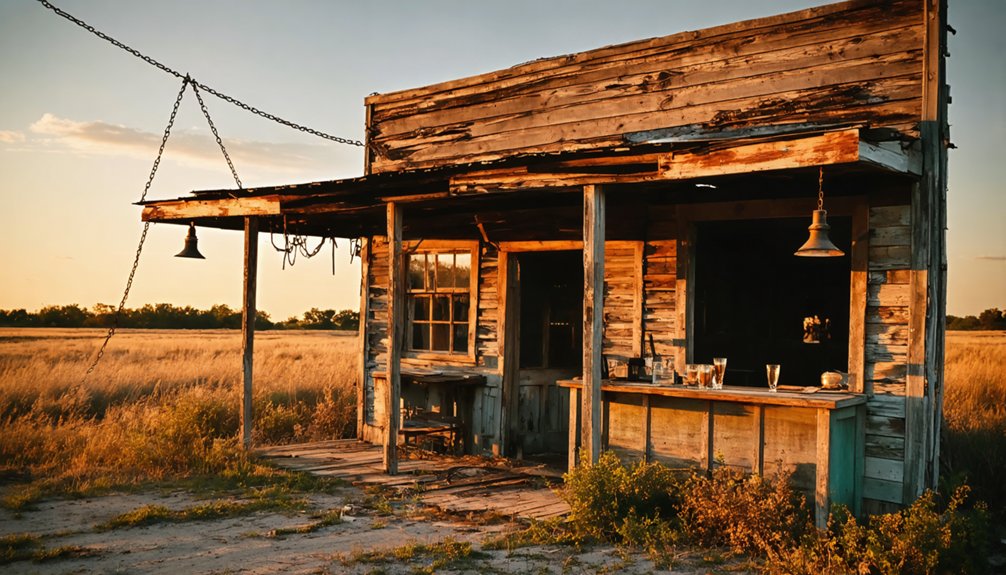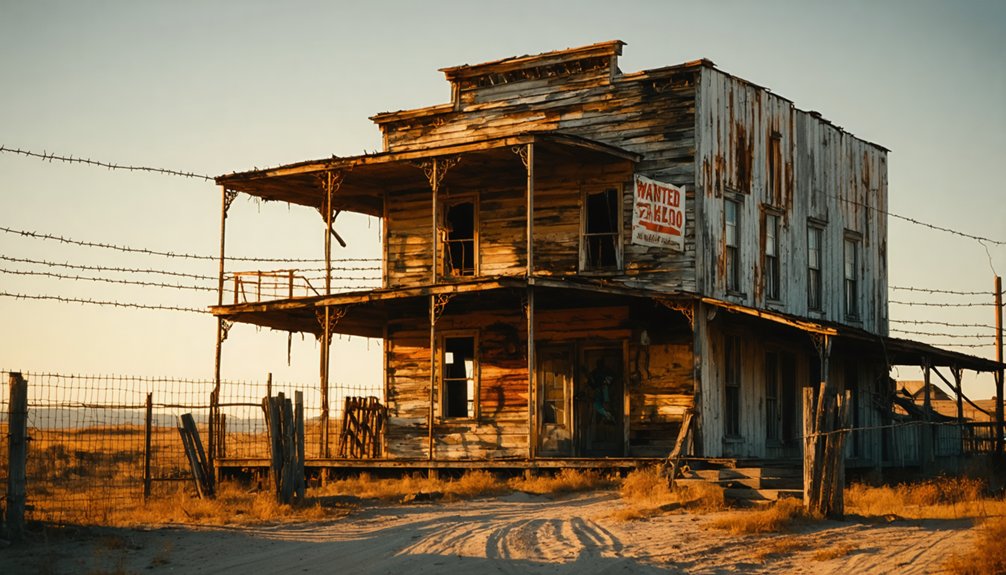Texas’s abandoned towns tell haunting stories of the Old West: Indianola, wiped out by devastating hurricanes; Terlingua, a mercury mining ghost town in the Chihuahuan Desert; St. Mary’s of Aransas, once a maritime powerhouse undone by storms; Pumpville, a critical railroad stop rendered obsolete by technology; and Tascosa, the lawless “Cowboy Capital of the Panhandle.” Each settlement’s crumbling ruins offer silent testimony to boom-and-bust cycles that shaped the Lone Star State’s frontier history.
Key Takeaways
- Indianola was Texas’ second busiest port before two devastating hurricanes in 1875 and 1886 led to its abandonment.
- Terlingua thrived as a mercury mining town until the 1970s when depleted mines and falling prices ended operations.
- St. Mary’s of Aransas declined from a maritime powerhouse after destructive storms and railroad competition redirected shipping traffic.
- Pumpville served as a critical railroad water stop until diesel engines replaced steam locomotives in the 1950s.
- Tascosa, once the “Cowboy Capital of the Panhandle,” collapsed when railroads bypassed it and barbed wire changed ranching practices.
Indianola: The Gulf Port Swept Away by Nature’s Fury
Before fading into the mists of Texas history, Indianola stood as one of the most promising port cities on the Gulf Coast, a reflection of human ambition ultimately humbled by nature’s overwhelming power.
Founded in 1846, this bustling harbor quickly became Texas’ second busiest port, welcoming thousands of German immigrants who’d shape Central Texas culture for generations.
A gateway to dreams, Indianola welcomed Europe’s hopeful to Texas shores, forever altering the cultural landscape.
You can trace Indianola’s immigrant legacy through towns like New Braunfels that sprouted from these newcomers’ dreams.
But hurricane devastation proved insurmountable. The 1875 Category 3 storm destroyed 75% of buildings, killing 300 residents.
Remarkably, many rebuilt—only to face the catastrophic 1886 hurricane that obliterated all but two structures. Today, visitors can see the courthouse foundation underwater, a haunting reminder of the city’s former grandeur. After the second hurricane, the town was officially pronounced dead in 1887 as the last residents finally abandoned their hopes for the once-thriving port.
Terlingua: Mercury Mining Ruins in the Desert Landscape
Deep in the rugged Chihuahuan Desert landscape, where the sun scorches the earth and mountains rise like ancient sentinels, lies Terlingua—a symbol of America’s industrial ambition and eventual abandonment.
Terlingua history traces to the 1880s when mercury mining began after Indian threats subsided. Howard E. Perry transformed primitive operations by establishing the Chisos Mining Company in 1903, which became America’s largest mercury producer.
You’ll find remnants of the Scott Furnace installed in 1908 and infrastructure that once supported 2,000 residents. The thriving settlement featured a unique cultural blend of Mexican and American traditions during its peak years. During World War I, increased military demand drove an economic boom with profits reaching 2,000 dollars daily.
The boom couldn’t last. By 1942, depleted mines and falling prices forced bankruptcy. Though briefly revived by government price guarantees in the 1950s, operations ceased by 1973.
Today, weathered ruins and a historic cemetery—filled with miners who succumbed to mercury poisoning—stand as evidence to both opportunity and exploitation.
St. Mary’s of Aransas: Lost Maritime Legacy on Copano Bay
Along the placid waters of Copano Bay, where the Texas coastline unfolds into sheltered harbors and tidal marshes, once stood St. Mary’s of Aransas—a maritime powerhouse you’d scarcely recognize today.
In the mid-19th century, this bustling port surpassed neighboring settlements, becoming western Texas’s premier shipping center for cattle, cotton, and lumber.
You can trace the town’s economic decline to devastating back-to-back storms in 1886-87 that destroyed its essential wharves.
When the San Antonio and Aransas Pass Railroad reached nearby Rockport in 1888, St. Mary’s fate was sealed.
By the 1890s, this once-thriving commercial hub had dwindled to a village.
Developed by Joseph F. Smith, St. Mary’s emerged as a significant lumber center before the Civil War, attracting merchants and shipping interests to its strategic location.
Today, maritime history enthusiasts explore archaeological remnants like the SS Mary shipwreck—silent witnesses to St. Mary’s former prominence and sudden abandonment. The tragic sinking came after the vessel struck a buoy while attempting to navigate through the challenging Aransas Pass during high seas in November 1876.
Pumpville: From Thriving Settlement to Crumbling Adobe
While St. Mary’s vanished beneath the tides, Pumpville’s decline tells a different tale of ghost town history. Established in 1882 as a critical water stop for Southern Pacific steam locomotives, this settlement’s fate was inextricably tied to railroad impact.
You’ll find Pumpville’s story emblematic of technological evolution’s cost—when diesel engines replaced steam in the 1950s, the town’s purpose evaporated.
The railroad’s withdrawal after WWII triggered a cascade of closures: depot (1952), water service (1955), school (1957), and finally the church (1970).
Even the dramatic 1965 shooting of postmaster Bradford by the “caveman bandit” couldn’t halt Pumpville’s descent into abandonment.
Today, only crumbling foundations and the reopened Baptist church remain—silent monuments to a community that rose and fell with the railroad’s needs. Like many semi-abandoned sites across Texas, Pumpville’s status remains undefined in official classifications. The town’s historical significance is underscored by the Black Jack Ketchum train robbery of 1897, which netted the infamous outlaw $6,000 in stolen goods.
Tascosa: Where Cowboys and Outlaws Once Roamed
Unlike Pumpville’s gradual demise, Tascosa erupted onto Texas’s frontier landscape in 1876 when Mexican sheepherders established the first permanent settlement near a critical Canadian River crossing.
You’d find this “Cowboy Capital of the Panhandle” rivaled Dodge City for its untamed spirit, with cowboy culture thriving amid its brothels, saloons, and gambling halls.
Notorious figures like Billy the Kid and Pat Garrett frequented this lawless haven where frontier justice claimed 26-28 lives between 1880-1886 alone. G.W. “Cap” Arrington described it as “the hardest place on the frontier.”
Tascosa’s strategically important location made it Oldham County’s seat in 1880, but progress ultimately sealed its fate.
By 1887, barbed wire enclosed the town, railroads bypassed it, and residents fled.
The area experienced new life in 1939 when Julian Bivins donated the property for Cal Farley’s Boys Ranch, transforming the former wild frontier settlement.
Frequently Asked Questions
Are These Ghost Towns Legally Accessible to the Public?
Dusty saloons stand empty while legal restrictions vary. You’ll find some ghost towns offer public access through historical parks, while others remain private property requiring explicit permission before exploration.
What Items Can Visitors Collect as Souvenirs From These Sites?
You shouldn’t collect artifacts from ghost towns. Instead, direct your souvenir hunting toward local crafts, photography, and authorized gift shop items that honor these historical places without compromising their integrity.
When Is the Best Season to Photograph Texas Ghost Towns?
Autumn beckons, spring calls, but fall reigns supreme for photography techniques. You’ll capture ideal seasonal lighting during October-November when crisp air enhances visibility and golden light dramatizes weathered structures’ textural nuances.
Do Any Abandoned Towns Host Historical Reenactments or Guided Tours?
Yes, you’ll find Terlingua and Ghost Town Texas offering rich historical reenactments and guided tours, preserving their historical significance while generating substantial tourism impact through authentic cultural experiences.
What Paranormal Activities Have Been Reported in These Locations?
If walls could talk, you’d hear of ghost sightings in these haunted locations—apparitions, disembodied voices, temperature drops, mysterious footsteps, and shadow figures frequently manifest in Terlingua, Hagerman, and Galveston’s historic districts.
References
- https://en.wikipedia.org/wiki/List_of_ghost_towns_in_Texas
- https://www.twtex.com/forums/threads/texas-ghost-towns-proposal.33379/
- https://texashighways.com/travel-news/four-texas-ghost-towns/
- https://www.thc.texas.gov/public/upload/publications/texas-heritage-travel-guide.pdf
- https://www.youtube.com/watch?v=AsCuwE0joO0
- https://www.youtube.com/watch?v=DRn0IjjUpOw
- https://tpwmagazine.com/archive/2018/jan/wanderlist_ghosttowns/
- https://www.simplytexan.com/truly-texan/abandoned-ghost-towns-in-texas/
- https://www.hipcamp.com/journal/camping/texas-ghost-towns/
- https://authentictexas.com/texas-ghost-towns/



